Papaya Flower – Manadonese Cuisine Provincial Indonesian Food by Petty P Elliot
Having recently met Indonesian food writer, Petty P Elliot, my curiosity in Indonesian cuisine and culture has been reawakened, moreover enlightened and fascinated with her book, ‘Papaya Flower, Manadonese cuisine Provincial Indonesian food’, inciting a compulsion to discover more on this (undiscovered) cuisine.
I am sure Indonesia is an enigma to many, even though it is the world’s 4th largest most populated country, 240 million people in fact, which is more than the combined population of England, France, Italy and Spain; but are we familiar with Indonesian cuisine or culture?
Perhaps the universal engrossment with money and recent revelations that Indonesia is approaching being a trillion dollar economy and that it is after all the biggest economy in Southeast Asia might have us thinking beyond nasi goreng and sate.
Standard Chartered bank expects Indonesia’s economy to rise to $9 trillion by 2030, “which would make it the largest economy in size after China, the United States, India, Brazil and Japan; Indonesia’s economy would be bigger than Germany, Mexico, France and Britain”.
If that’s not reason enough for the world to start paying a lot more attention to this rapidly growing-evolving country-culture, well I’ll eat Adyuma.
Much of Indonesian mystery lies in its cultural diversity, indeed 300 ethnic groups with 742 different languages and dialects in an archipelago of 17,508 islands scattered across either side of the equator, of which 6000 are inhabited; there is much to explore!
Also consider that Indonesia has land borders with Malaysia in Borneo, Papua New Guinea, East Timor and is maritime neighbours within close proximity to Singapore, Malaysia, Philippines and Australia; there have been many centuries of complex cross-cultural influences on their cuisine and evolution of agriculture.
Indigenous evolution in Indonesia is no less complex or intriguing, spanning from the fascinating discovery of the Java Man, one of the first known homo erectus living on the banks of the Solo River, East Java over 1.5 million years ago, to the Austronesian whose roots go back to Taiwan and known to have migrated from 10,000-2500 BC, some of whom in turn interacted over many thousands of years with the Melanesians, the indigenous Papuan-speaking people of New Guinea.
No wonder those who delve into the history of the region become infatuated, even if most people’s first Indonesian encounter is Bali and seemingly tailored to western pampering and of ideals of nirvana; Bali itself has an incredibly rich culture and history and the gateway to discovering Indonesia.
So, with 17, 507 islands other than Bali to explore, where does one start?
Well, how about we explore one of the largest islands, Sulawesi, or more specifically exploring the Manadonese cuisine that has evolved around the city and region of Manado at the northern tip of this mountainous peninsula stretching out from the Bay of Manado to the Celebres Sea and neighbouring southern Philippine Islands.
Enter Penny P Elliot, not only peerless in her commentary and writing on Indonesian cuisine, also the author of a truly unique cookbook, ‘Papaya Flower – Manadonese Cuisine Provincial Indonesian Food’. Elliot is a Manadonese native of both Dutch and Manadonese ancestry and thoroughly passionate in her pursuit of championing Manadonese cuisine and illustrating the intriguing mosaic of flavours and cultural influences.
I asked Elliot for her general thoughts on Indonesian cuisine and how she feels it is perceived, to which she writes profoundly:
“As an Indonesian food writer – I sometimes feel I am a rarity – a silly notion given that I come from the fourth largest democracy in the world. There are 240 million Indonesians – so why does real Indonesian food remain an unknown?
It is still amazing to me that one struggles in leading international cities such as London (and England is my second home these days) – to find a decent Indonesian restaurant. With the possible exception of its former colonist, the Netherlands, South East Asia’s largest nation is so often overshadowed by greater familiarity with Thai, Vietnamese and Malaysian cuisine.
For many, Indonesian food equals fried rice, satay, gado-gado (blanced mix vegetables with peanut sauce), rendang (dried beef curry from Sumatra) and instant noodles. These fast food staples are indeed available everywhere in the archipelago, equivalent to British fish and chips or American hamburgers. But in truth how many of us foodies spend a micro-second on such offerings? So it’s long overdue to reveal the true potential of the Indonesian menu.
Pumpkin curry with fresh lemon grass and basil, stir fried papaya flowers and water spinach with smoked tuna, pork tenderloin with soya sauce, nutmeg and cloves or red snapper with grilled pineapple chillies and ginger. These are just a few of the regional dishes I have grown up with in Manado, North Sulawesi – flying time just three hours from Singapore.
Seeking a better-known destination? Try Bali. The land of the Gods has punched well above its weight in recent years, with well earned international publicity as a gourmet destination.
In Bali we are beginning to see change as leading international chefs are creating fantastic combinations from local ingredients, experimenting and adapting local dishes with modern cooking technique.
But Indonesia is more than Bali. Indonesia is beyond Bali. I think this is the window of opportunity, and the beginnings of some exciting new offerings from the land of spice.” Let’s discover the regional taste of Indonesia.”
There is a powerful message here and surely the awareness and popularity of (Indonesian) cuisine will grow in as much as their economy and importance on the worldwide stage.
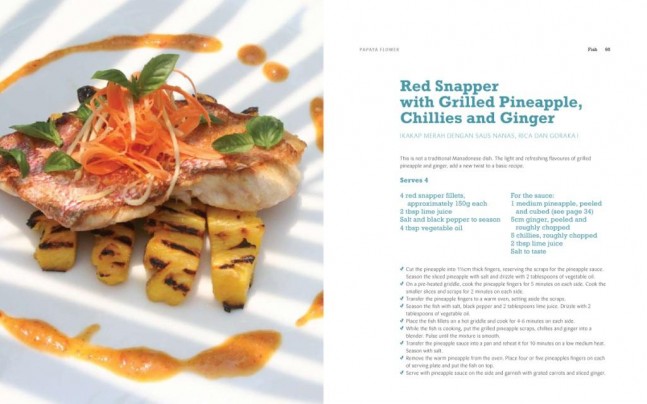
Papaya Flower - Red Snapper with grilled pineapple, chillies and ginger
Looking at Manadonese cuisine alone, history and foreign influence has imparted perhaps more than people realize and there will be some sense of familiarity amongst both western and eastern (Chinese) palates. As Elliot outlines in the introduction to her book, “It (Manadonese) is a very particular style of cuisine, strong in flavour and quite distinct from the fare elsewhere in Indonesia. One difference is the popularity of pork. Lying within the largest Muslim state in the world, North Sulawesi is predominantly Christian.”
The timeline of history tells us that the Portuguese and Spanish vied for control over these parts of South East Asia, the Portuguese attempting to secure Sulawesi by installing the Sultan of Ternate as their vassal however, it was the Spanish who eventually had the upper hand. Subsequently the Spanish traded possession of Northern Sulawesi to the Portuguese although they were outsmarted by the Dutch (Dutch East India Company) who had already forged an alliance with the natives (Minahasa) and it remained a Dutch Colony until the Japanese invasion and even more bloody war, the Indonesian War of Independence at the end of World War II, with succession in 1949.
I should mention the British were also vying for power in the region over the same period of time with the British (East India Company) becoming increasingly hostile (and ambitious) throughout the Malay Peninsula as the Anglo-Dutch wars unfolded in the 17th and 18th Century.
Meanwhile Chinese traders and Malay fisherman went about their business with cross-culture marriages imparting their own influences on Manadonese cuisine with seafood a large part of the diet. As Elliot puts it, “Located on a peninsula, nowhere in Manado is further than an hour and half from the coast, ensuring both seafood and freshwater fish from the inland lakes are perennial favourites”.
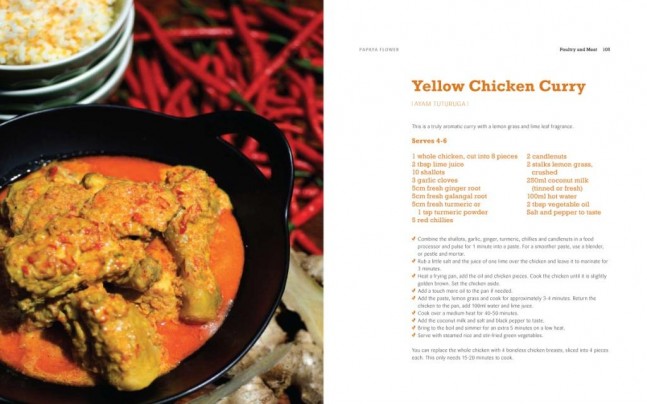
Papaya Flower - Yellow Chicken Curry
It is intriguing though and testimony to the distinct cultural differences in Indonesia, as pointed out by Elliot in her depiction of Manado history, pre-colonial times, “The settlers of this idyllic and remote finger of land atop Sulawesi seemed to have been able to evolve a lifestyle and culture based on their Austronesian heritage, largely undisturbed until the arrival of the Europeans. In comparison to other parts of Indonesia and the Philippines, the influence of either Islam or the cultures of India was negligible. There is little evidence of Hinduism, no Indic scripts and very few linguistic borrowings in local dialect.
As distinct from Bali, with its Hindu majority and yet also under Dutch rule, albeit a far more tumultuous relationship, it is fascinating that in relatively close proximity and under the same colonial power that such cultures and cuisines could be so different moreover, nothing much has changed to this very day.
Elliot describes Manadonese cuisine as using “many South East Asian favourites: chillies, lemon grass, ginger, galangal and turmeric. It is a very particular style of Indonesian cuisine, strong in flavour and quite distinct from fare elsewhere in Indonesia.” She goes on to say, “The Manado have a reputation throughout the archipelago for preparing some of Indonesia’s spiciest food.”
Thankfully, she has reduced the quantities of chilli in all of her recipes and whilst she aims to “re-kindle interest in Manadonese cuisine in its purest form”, she takes a pragmatic and contemporary approach to fresh ingredients and techniques, “without losing the unique taste and of the spices and herbs in use for hundreds of years.”
Elliot’s chapter on ingredients is captivating, articulately explaining spices, herbs and fresh produce and superbly illustrated with original photography by Jakarta based professional photographer, Melbourne. Indeed, the photography throughout the book is brilliant and every dish is pictured; I don’t know about you, but food photography is paramount and a picture of each dish an imperative as far as guidance and both cooking and presenting the dish.
Indeed, this is not only a well-presented and formatted cookbook, it is thoroughly user-friendly and practical in its clear layout and recipe flow; presented in a manner that one can sense someone who cooks at home and understands the boundaries of the home-cook and the limitations of a home kitchen. Too many cookbooks, authored by chefs, end up with dishes deconstructed in a complex and disconcerting manner that only professionals and obsessive gourmands can follow.
Manadonese cuisine utilises basic Asian cooking methods such as the wok for frying and braising but also young palm leaves and banana leaves are used for steaming a barbecuing and even though modern lifestyle has infiltrated Manado, traditional cooking methods remain much the same.
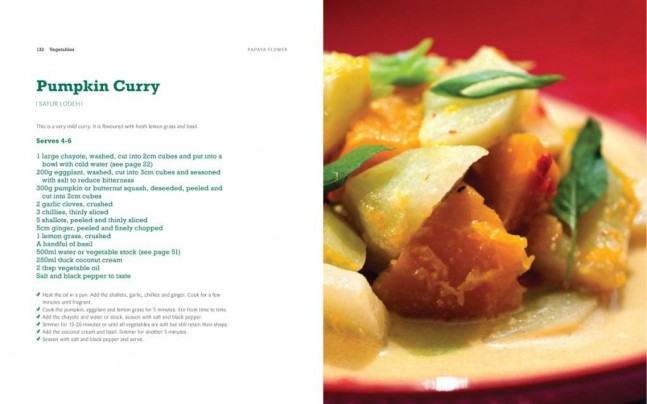
Papaya Flower - Pumpkin Curry
Vegetarians will gain much from book in expanding and spicing up their repertoire with both the ‘Vegetable’ and ‘Rice and Noodle’ chapters offering dishes and recipes of wonderfully exotic ingredients and complex flavours, including a Manadonese Risotto with pumpkin, sweet potatoes, corn and spinach. No, the Italian’s did not invade Manado more the fact rice has been a staple here and trading commodity here for Centuries.
There are also vegetables soups, Grandma’s spicy pumpkin soup, Mung Bean, carrot and potatoes soup incorporating exotic spices, and salads using papaya, pomelo and mango that have their similarities to Malay and Thai flavours.
There is a surprisingly large dessert section, although not strictly Asian sweets, and underscores Elliot’s contemporary approach to Indonesian cuisine. Her recipes and interpretations are indeed modern and her approach not constrained by the rigidity of ‘authenticity’.
Authenticity in cuisine is a mute point, as Anthony Bourdain verbalizes in his recent book, Medium Raw, leaving out some of his animated vernacular, “What does ‘authentic’ mean, anyway? Creole, by definition, is a cuisine and a culture undergoing slow but constant change since its beginnings, a result of gradual, natural fusion—like Singapore or Malaysian flavours and ingredients changing along with who’s making babies with who, and for how long… the term ‘authentic is essentially meaningless. ‘Authentic’ to when? ‘Authentic’ to whom?”
And this is what I find refreshing in Elliot’s approach to her book; that she is not bogged down in ‘authenticity’ or tradition rather, in reuniting herself with her homeland she has absorbed all the transitions and evolution of Manado and applied her personal, contemporary ideologies and techniques without compromising the purity and wholesomeness of the local ingredients with the emphasis on great produce.
It is an uncomplicated book that has no intention of being a scholarly reference and is I would suggest purposely abridged in content and pictorial to appeal to those discovering Asian cuisines, and those who like cookbooks that are practical and will actually be helpful in exploring and cooking an unfamiliar cuisine.
That said I can sense Elliot’s is working cautiously within realistic constraints, and she would happily produce a tome on Indonesian cooking, and perhaps she will, as she has embarked on a monumental journey of culinary discovery.
For the meantime she is pursuing her passion with this commendably self-published entree. We are also hoping Elliot will share her ongoing discoveries on the Wandering Palate website.
Papaya Flower, Manadonese cuisine Provincial Indonesian food, is published by Komunika Partners ISBN 978-602-95717-0-7 and available in specialist bookstores or by contacting her direct at pettyelliot@yahoo.com Tel: +62816922099
- Reference: Papaya Flower Manadonese cuisine Provincial Indonesian food and Wikipedia
|
|
Tweet |

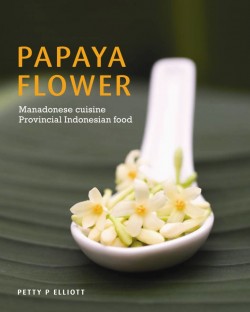
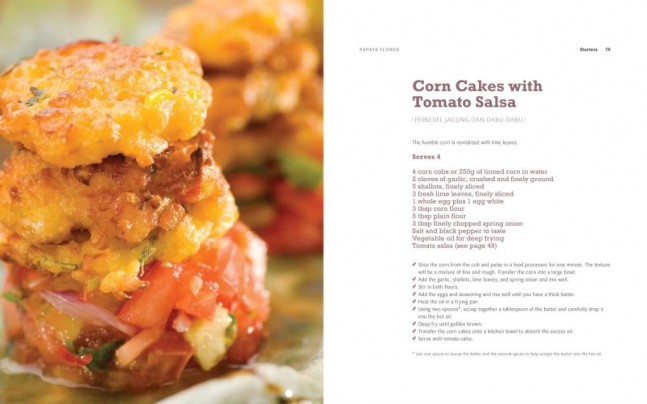




One comment to The Wandering Palate Best Cookbook Discovery of the Lunar Year | Comments Feed
Christie,Have to tell you, you are an amazing tanlet! If you can remove crows feet, reduce me by 30 pounds, get rid of all the extra chins, you are my hero!
The comments are closed.